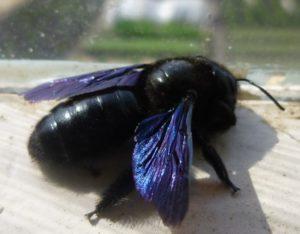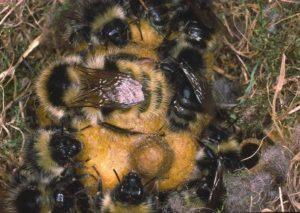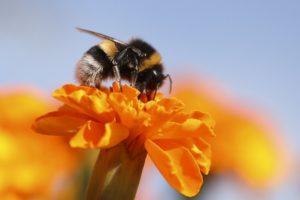What do bumblebees eat and how do loud flyers live
In the warm season, along with bees, bumblebees also participate in the pollination of plants. They are much larger than their relatives, and differ from them in body structure. But their large and formidable appearance should not frighten - bumblebees do more good than harm.
Content
What does a bumblebee look like: photo
Description of the insect
Name: Bumblebees
Latin: BombusClass: Insects - Insecta
Squad: Hymenoptera - Hymenoptera
Family: Real bees - Apidae
 | Habitats: | garden and vegetable garden, meadows, flowers |
 | Features: | social insects, good pollinators |
 | Benefit or harm: | useful for plants, but sting people |
The bumblebee got its name from the wheezing or buzzing sound it makes while flying. This is a social insect that forms a new colony every year.
Shades
Insects of this species have a variety of body colors, consisting of black or dark and bright yellow, red, gray or orange stripes. Some representatives are brown, blue.
The color of bumblebees depends on the balance between camouflage and thermoregulation. Each type of insect has its own specific body color by which they can be distinguished. Females are slightly larger than males. The body length of the female is from 13 to 28 mm, the male is from 7 to 24 mm.
Structure and dimensions
The head of females is elongated, while that of males is triangular or round.
The mandibles are powerful, the bumblebee is able to gnaw through the plant fibers that it uses to create nests.
The eyes are without hairs, set in a straight line, the antennae of males are slightly longer than those of females.
Bumblebees have a long proboscis that allows them to collect nectar from plants that have a deep corolla.
Their abdomen is not bent to the top; at its end, females and working bumblebees have a sting in the form of a needle, without notches. The bumblebee stings the prey, and the sting pulls it back.
The insect has 3 pairs of legs, the females have “baskets” on their legs for collecting pollen.
Their body is covered with hairs that help the insect regulate its body temperature and a lot of pollen clings to them. The body of the bumblebee is thick and heavy, the wings are transparent, small, consisting of two halves.
The bumblebee makes 400 strokes per second, the halves of the wings move synchronously, and it can reach a speed of 3-4 meters per second.
Food
Insects feed on nectar and pollen, which are collected from various types of plants. Bumblebees use nectar and honey to feed their larvae. In its composition, bumblebee honey is different from bee honey, but more useful, although it is not as thick and less sweet and fragrant.
The most common types of bumblebees
Bumblebees live in different regions and differ in size and body color. Often there are such types:
- earth bumblebee;
- stone;
- meadow;
- urban;
- garden;
- field;
- burrow;
- reddish bumblebee;
- silver;
- moss;
- bumblebee carpenter;
- cuckoo bumblebees.
Where do bumblebees live
Bumblebees are able to survive in cold areas, and in the tropics it is more difficult for them to live because of the peculiarities of their thermoregulation. The body temperature of a bumblebee can rise to +40 degrees, due to the fact that it quickly contracts the pectoral muscles, but the wings do not move.
This is the source of the loud buzz. When it buzzes, it means it warms up.
These insects are found in nature on all continents except Antarctica. Some species of bumblebees live beyond the Arctic Circle, in Chukotka, Alaska, and Greenland. They can also be found:
- in Asia;
- South America;
- Africa;
- Australia
- New Zealand;
- England.
bumblebee nest
Insects build their dwellings underground, on the ground or even on a hill. If bumblebees live near people, they can build their nests under the roof, in a birdhouse, in a hollow.
The nest is usually shaped like a sphere, but it depends on the cavity in which it is located. Bumblebees build it from dry grass, straw and other dry materials, fastening them with wax, which is secreted from special glands on the abdomen.
Reproduction
The bumblebee family consists of the queen, males and worker bumblebees. If something happens to the queen, working females can also lay eggs.
The family lives only one season, from spring to autumn. It can have 100-200 individuals, sometimes it can be very large - up to 500 individuals. Some types of bumblebees can give 2 generations, these are the meadow bumblebee and Bombus jonellus, which lives in southern Norway. Bombus atratus lives in the Amazon River basin, the families of which can exist for several years.
In the nest of bumblebees, duties are distributed among family members:
- the uterus lays eggs;
- worker bumblebees, which are smaller in size, take care of the larvae, repair the inside of the nest and guard it;
- large individuals fly for food and repair the dwelling outside;
- males are needed to fertilize females, they fly out of the nest and never return to it.
Life cycle
Bumblebee developmental stages:
- egg;
- larva;
- pupa;
- adult individual (imago).
At the end of summer, the queen lays eggs, from which males and young females will appear, which the males fertilize. These females will survive the winter and give birth to a new generation the next year.
What are useful bumblebees
Bumblebees pollinate different plants, they fly from flower to flower faster than bees and pollinate many more plants. They also fly out in cool weather, when the bees do not leave the hive.
In areas where the ambient temperature is very low at night, bumblebees hum very loudly before dawn. But for a long time it was believed that in this way the bumblebees tune in to work in the morning and call their comrades to it. In fact, this is how they heat up.
bumblebee stings
Bumblebees are not aggressive, they do not attack first. Only females have a sting and they can sting only when protecting their nest, or when they are in danger. Redness, itching usually appears at the bite site, and disappears within 1-2 days. And for most people, the bite is not dangerous.
In rare cases, an allergic reaction occurs.
Enemies of bumblebees
The formidable hairy bumblebees have several enemies that can hunt them.
- Ants cause great harm to bumblebees, they eat honey, steal eggs and larvae.
- Some species of wasps steal honey and eat larvae.
- Canopy flies on the fly stick an egg to the bumblebee, from which a little face appears, and it eats its host.
- The offspring of bumblebees is destroyed by the caterpillar of the amophia butterfly.
- The golden bee-eater bird pecks at bumblebees collecting nectar.
- Foxes, hedgehogs and dogs will destroy nests.
- Cuckoo bumblebees climb into the nests of their relatives and harm them.
Interesting Bumblebee Facts
- To spend the winter, the female digs a mink and hides in it, but then forgets about this ability and in the spring uses ready-made holes in the ground for her nest.
- Bumblebees are bred in special farms. They are used to pollinate some types of crops such as legumes and clover.
- Some hobbyists breed bumblebees and collect honey, which is healthier than bee honey.
- In the morning, a trumpeter bumblebee appears in the nest, which buzzes strongly. Some thought that this is how he wakes up the family, but later it turned out that in the morning the air is cold and the bumblebee tries to warm up by intensively working with the pectoral muscles.
- Previously, it was believed that according to the laws of aerodynamics, a bumblebee should not fly. But a physicist from the United States proved that the bumblebee does not fly contrary to the laws of physics.
Bumblebee population
It has been observed that in recent years the population of bumblebees has decreased. There are several reasons for this:
- Incorrect use of insecticides, especially during flowering.
- When building a nest, bumblebees often fly into the premises, cannot get out or die.
- People themselves reduce the population when the neighborhood with insects becomes dangerous or inconvenient.
Conclusion
Bumblebees are beneficial insects that pollinate various plants. There are about 300 species of them, they differ from each other in size and stripes on the body. They live in the Amazon and beyond the Arctic Circle.
Previous



